机器人技术——从自动化到智能系统
机器人的智能化与自动化

机器人的智能化与自动化随着科技的迅猛发展,机器人已经逐渐成为现实生活中不可或缺的一部分。
是机器人技术发展的重要方向,它们的不断进步使得机器人能够更好地为人类服务,解放人们的劳动力,提高生产力。
智能化是指机器人能够具备类似甚至超过人类的智能水平,具备感知、认知、理解、学习、推理等能力。
许多先进的机器人已经可以通过传感器感知到周围的环境,并能够根据感知结果做出相应的反应。
例如,一些清洁机器人能够通过激光导航系统感知到家庭中的障碍物,并能够智能规划清洁路线,以提高清洁效率。
另外,智能机器人还可以通过机器视觉技术来识别物体,并进行抓取和搬运操作,如在工业生产中用于装配产品。
还有一些机器人能够通过语音识别技术与人进行自然语言交互,实现智能对话,如智能助理机器人。
智能化的核心是机器学习和人工智能技术的应用。
机器学习是指机器通过从大量数据中学习并自动识别和应用模式的能力。
人工智能技术则是让机器模拟人类的智能行为和思维过程的技术。
这些技术的应用使得机器人能够从经验中学习,并根据学习的结果做出决策。
例如,一些金融领域的机器人可以通过分析大量的金融数据,学习并预测市场趋势,为投资者提供投资建议。
另外,医疗领域的机器人可以通过学习医学知识和临床案例,帮助医生进行诊断和治疗决策。
自动化是指机器人能够独立地进行任务执行,不需要人工干预。
自动化的核心是机器人的感知和控制系统。
感知系统通过传感器实时获取周围环境的信息,并将信息传输给控制系统。
控制系统根据感知结果进行决策,并通过执行机构实现物理操作。
例如,一个自动化的仓库机器人可以通过摄像头获取货架上物品的信息,然后根据物品的位置和数量进行抓取和搬运操作。
自动化的目标是实现生产过程的高效化和标准化。
机器人在生产线上可以取代繁重、危险、重复性工作,提高生产效率和质量。
例如,汽车工厂中的焊接机器人能够快速、准确地完成焊接任务,与人类相比大大缩短了生产周期。
另外,自动化还可以减少人为因素对生产过程的干扰,提高生产的稳定性和安全性。
自动化前沿科普

自动化前沿科普自动化技术作为一项前沿科学技术,正在改变着我们的生活形态。
它的发展促进了工业生产的智能化和自动化程度的提升,使得许多行业迎来了高效率和可持续发展的机遇。
本文将从机器人、人工智能和自动控制等方面介绍自动化技术的前沿发展。
一、机器人——智能化的助手机器人是自动化技术的重要应用领域之一,它通过模拟人类的动作和思维,完成各种任务。
近年来,随着人工智能技术的快速发展,机器人变得越来越智能化。
例如,工业机器人已经能够替代人工完成一些繁重、危险或重复性的工作,大大提高了生产效率。
而在服务领域,社交机器人能够与人进行沟通互动,为人们提供信息查询、休闲娱乐或康复护理等服务。
二、人工智能——智能科技的代表人工智能是自动化技术的核心和灵魂,它使得计算机能够模拟和实现人类的智能行为。
目前,人工智能在图像识别、语音识别、自然语言处理等方面取得了巨大的突破。
例如,人们通过人脸识别技术来解锁手机、支付购物等操作已经非常普遍。
此外,智能语音助手成为人们生活中的得力助手,能够听懂我们的指令并提供相应的服务。
三、自动控制——实现系统优化自动控制是自动化技术的关键环节,它通过电子技术和计算机技术实现对系统的自动监测和控制。
自动控制可应用于制造业、能源管理、交通运输等领域。
例如,工业过程中的自动化控制系统能够自动监测生产过程中的温度、湿度、压力等参数,及时调整生产环境,提高生产效率和产品质量。
在智能交通领域,自动驾驶技术正在逐渐成熟,为我们提供了更安全、更便捷的出行方式。
四、前沿技术带来的挑战和机遇虽然自动化技术取得了许多进展,但也面临着一些挑战。
首先,随着机器人和人工智能的普及,人们对于人机交互性能、隐私保护等问题的关注度也在增加。
其次,自动化技术的快速发展对劳动力市场产生了一定的冲击,需要关注人们的职业发展和就业问题。
然而,自动化技术也为社会带来了许多机遇。
它可以降低生产成本,提高生产效率,为工业转型升级提供加速器。
机器人技术在智能制造装备自动化上的应用与研究
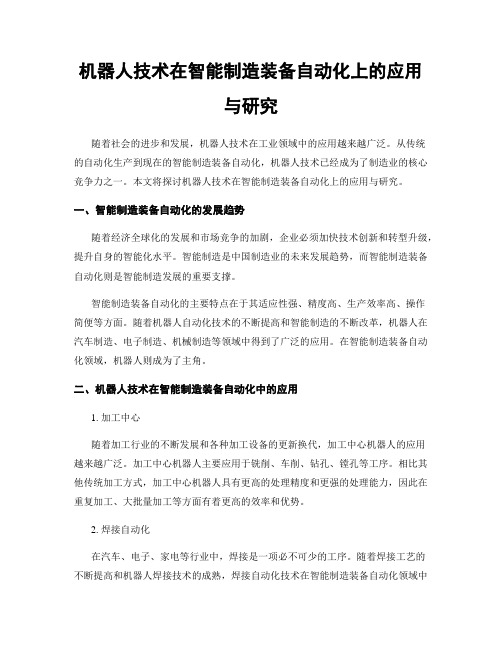
机器人技术在智能制造装备自动化上的应用与研究随着社会的进步和发展,机器人技术在工业领域中的应用越来越广泛。
从传统的自动化生产到现在的智能制造装备自动化,机器人技术已经成为了制造业的核心竞争力之一。
本文将探讨机器人技术在智能制造装备自动化上的应用与研究。
一、智能制造装备自动化的发展趋势随着经济全球化的发展和市场竞争的加剧,企业必须加快技术创新和转型升级,提升自身的智能化水平。
智能制造是中国制造业的未来发展趋势,而智能制造装备自动化则是智能制造发展的重要支撑。
智能制造装备自动化的主要特点在于其适应性强、精度高、生产效率高、操作简便等方面。
随着机器人自动化技术的不断提高和智能制造的不断改革,机器人在汽车制造、电子制造、机械制造等领域中得到了广泛的应用。
在智能制造装备自动化领域,机器人则成为了主角。
二、机器人技术在智能制造装备自动化中的应用1. 加工中心随着加工行业的不断发展和各种加工设备的更新换代,加工中心机器人的应用越来越广泛。
加工中心机器人主要应用于铣削、车削、钻孔、镗孔等工序。
相比其他传统加工方式,加工中心机器人具有更高的处理精度和更强的处理能力,因此在重复加工、大批量加工等方面有着更高的效率和优势。
2. 焊接自动化在汽车、电子、家电等行业中,焊接是一项必不可少的工序。
随着焊接工艺的不断提高和机器人焊接技术的成熟,焊接自动化技术在智能制造装备自动化领域中得到了广泛的应用。
机器人在焊接过程中可以取代人工,实现无人化操作,同时可以实现焊接的快速、高效、精准、稳定,提高焊接质量、效率和安全性。
3. 搬运系统机器人搬运系统主要应用于物流、仓储、生产线等领域。
机器人搬运系统可以通过机械手臂完成物料的搬运、堆垛、转运、输送等工作,可以大大提高物流效率和降低效率成本。
在智能制造领域中,机器人搬运系统可以有效地将智能仓储、智能分拣等技术与智能制造装备自动化技术相结合,形成一种高效的生产系统。
三、机器人技术在智能制造装备自动化中研究进展1. 机器人自适应调节方法机器人自适应调节方法是一种基于机器人优化控制的技术。
01-智能机器人系统-绪论-从机器人到智能机器人

智能机器人系统绪论主讲人:郑志强国防科技大学智能科学学院机器人“制造业皇冠顶端的明珠”机器人“制造业皇冠顶端的明珠”由于大数据、云计算、移动互联网等新一代信息技术同机器人技术相互融合步伐加快,3D打印、人工智能迅猛发展,制造机器人的软硬件技术日趋成熟……军用无人机、自动驾驶汽车、家政服务机器人已经成为现实,有的人工智能机器人已具有相当程度的自主思维和学习能力……我就在想,我国将成为机器人的最大市场…….我们要审时度势、全盘考虑、抓紧谋划、扎实推进。
——习主席在2014年两院院士大会上的讲话机器人的定义机器人是一个可计算机编程的机器,能够自动地执行一系列复杂的动作。
机器人可通过外部控制设备或者内嵌的控制系统导引。
机器人可能按照人类的模样构建,但是大多数机器人是设计来执行特定任务的机器,而不考虑其模样。
机器人的定义A robot is a machine—especially one programmable bya computer—capable of carrying out a complex series ofactions automatically.Robots can be guided by an external control device or the control may be embedded within.Robots may be constructed to take on human form butmost robots are machines designed to perform a task with no regard to how they look.https:///wiki/Robot机器人的实例机器人可以是自主的、半自主的、遥控的。
机器人包括类人机器人、工业机器人、服务机器人、医疗机器人、娱乐机器人、康复机器人、群体机器人、无人机、无人车、无人艇、微纳米机器人……机器人的实例类人机器人焊接机器人四足仿生机器人机器人的实例手术机器人拟人机器人阿西莫夫-机器人三法则机器人不能伤害人类,或坐视人类受到伤害而袖手旁观除非违背第一法则,机器人必须服从人类的命令在不违背第一和第二法则前提下,机器人必须保护自己阿西莫夫-机器人三法则阿西莫夫提出的“机器人三原则”为机器人规定了伦理性纲领,一直是机器人科学家研究开发工作的准则。
机器人和自动化技术的发展和应用

机器人和自动化技术的发展和应用近年来,随着科技的发展,机器人和自动化技术在各个领域得到广泛的应用。
机器人不仅可以在生产制造等工业领域中发挥重要作用,也可以在医疗、教育、物流等领域中起到重要的作用,已成为研究热点和应用重点。
本文将对机器人和自动化技术的发展和应用进行深入的探讨。
一、机器人和自动化技术的发展历程机器人起源于工业制造,最早出现在20世纪50年代。
起初,机器人主要用于替代人力,以提高生产效率和质量。
而如今,随着科技的不断进步,机器人的应用领域不断扩展,越来越多的机器人被应用到了医疗、教育、农业、交通等领域,成为人们生活中的重要组成部分。
随着机器人的不断发展,自动化技术也得到了广泛的应用。
自动化技术指的是利用计算机和其他技术手段,实现对生产过程中各个环节的控制和管理。
于是,通过大量的控制与异常管理算法的运用,工业生产领域实现了大规模生产,从而大大提高了产品的质量和生产效率。
二、机器人和自动化技术的应用1. 工业制造领域在工业制造领域,机器人和自动化技术的应用可以极大地提高生产效率和质量。
通过对生产过程的自动化控制和管理,可以实现各个环节的高效运转,从而使生产效率得以大幅度提高。
例如,通过电子设备制造中的智能机械臂,可以实现电路板的精准焊接和安装。
同时,机器人可以在生产过程中承担一些危险和高风险的任务,如危险品运输、核原料加工等工作,使人类免除了一些危险和高风险的工作。
2. 医疗领域在医疗领域,机器人可以承担一些需要高度精确度和耐心的操作,例如外科手术。
同时,机器人还可以承担护理和康复等工作。
例如,在康复中心中,可以利用机器人协助患者进行运动治疗,提高康复速度和效果。
此外,机器人还可以承担一些监管和管理工作,例如对病房进行巡视,记录病人的生命体征,提高病人的生活质量。
3. 教育领域在教育领域,机器人可以成为一种新的教育手段。
例如,在小学中使用编程机器人教学,教导学生编写简单的编程代码。
利用这样的教学方法,孩子们可以更好地理解编程思想,从而提高他们的IT技术水平。
智能制造发展历史

智能制造发展历史1. 从自动化到智能化大概从中学开始,人们就接受一个概念:人和动物最根本的区别在于使用工具。
英国伟大的动物学家珍妮·古道尔(Jane Goodall)发现,黑猩猩可以选择和加工工具,如去掉树枝的树叶,以树枝作为工具,伸进白蚁穴中捕捉白蚁。
和人类制造的工具相较,那种工具当然是最简单、最原始的,但这一现象足以颠覆人们关于人与动物根本区别的认知。
如果一定要从使用和制造工具的角度区别人和动物的话,恐怕需要对工具进行限定。
黑猩猩制作的工具,即树枝,虽然去掉了树叶,其实质和形态还是自然界本已存在的东西。
想想原始人制作的弓箭,其形态不是自然本来存在的。
因此,弓箭是“超自然存在”“超世界存在”的东西。
人类的文明史,从某一角度看,就是一部不断探究“超自然存在”“超世界存在”的历史。
人不断地通过创造“超自然存在”的工具(技术)去改善其生存问题。
农业文明开始后最简单的农具;中国古代的冶炼技术(如春秋失蜡铸造法,湖北省博物馆资料);汉代纺织机械;毕昇活字印刷;公元8世纪左右波斯的风车;14世纪意大利的机械钟和齿轮;18世纪的蒸汽机;及至现代的汽车、计算机……这些“超自然存在”的工具或技术越来越复杂,功能越来越强大。
敖德嘉•加塞特言,“称作‘技术’的最基本的事实只是起于如下奇怪的、戏剧般的、形而上学的事件:两种完全不同的实在——人和世界——以这样一种方式共存,即二者之一(人)要在另一者(恰恰是‘世界’)中建立‘超世界’的存在。
如何实现这一点的问题——类似于工程师的问题——正是‘人的生存’的主题。
”有一点需要注意的是,“我们开发技术以满足我们预想的需求,而不是为了满足自然所规定的一套普适需求。
用法国哲学家加斯东•巴歇拉尔的话说,就是:征服多余的比征服必需的能给予我们更大的精神刺激,因为人类是欲望的产物而不是需求的产物。
”这里可以看出人和动物在制作工具方面的最根本区别在于:动物没有对“超自然存在”“超世界存在”工具的欲求,而人对其的欲求和创造力则是无止境的。
自动化技术的发展历史
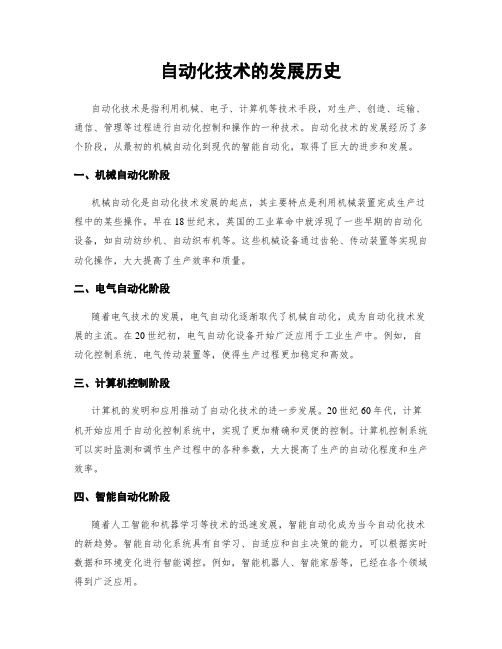
自动化技术的发展历史自动化技术是指利用机械、电子、计算机等技术手段,对生产、创造、运输、通信、管理等过程进行自动化控制和操作的一种技术。
自动化技术的发展经历了多个阶段,从最初的机械自动化到现代的智能自动化,取得了巨大的进步和发展。
一、机械自动化阶段机械自动化是自动化技术发展的起点,其主要特点是利用机械装置完成生产过程中的某些操作。
早在18世纪末,英国的工业革命中就浮现了一些早期的自动化设备,如自动纺纱机、自动织布机等。
这些机械设备通过齿轮、传动装置等实现自动化操作,大大提高了生产效率和质量。
二、电气自动化阶段随着电气技术的发展,电气自动化逐渐取代了机械自动化,成为自动化技术发展的主流。
在20世纪初,电气自动化设备开始广泛应用于工业生产中。
例如,自动化控制系统、电气传动装置等,使得生产过程更加稳定和高效。
三、计算机控制阶段计算机的发明和应用推动了自动化技术的进一步发展。
20世纪60年代,计算机开始应用于自动化控制系统中,实现了更加精确和灵便的控制。
计算机控制系统可以实时监测和调节生产过程中的各种参数,大大提高了生产的自动化程度和生产效率。
四、智能自动化阶段随着人工智能和机器学习等技术的迅速发展,智能自动化成为当今自动化技术的新趋势。
智能自动化系统具有自学习、自适应和自主决策的能力,可以根据实时数据和环境变化进行智能调控。
例如,智能机器人、智能家居等,已经在各个领域得到广泛应用。
总结:自动化技术的发展历史经历了机械自动化、电气自动化、计算机控制和智能自动化四个阶段。
从最初的机械装置到现代的智能系统,自动化技术在提高生产效率、降低成本、改善生产环境等方面发挥了重要作用。
随着科技的不断进步和创新,自动化技术将继续迎来新的发展,为人类创造更加便利和舒适的生活。
机器人技术概述3篇

机器人技术概述【第一篇】机器人技术的发展随着科技的不断进步,机器人技术已经成为了一个备受关注的热门话题。
机器人技术是指通过计算机、控制、感知等技术来实现人类活动的自动化,它广泛应用于工业、服务、医疗、军事等领域。
本篇文章将从机器人技术的历史、发展和应用方向三个方面进行介绍。
一、机器人技术的历史追溯到远古时期,人类就通过发明各种工具来帮助自己完成任务。
到了工业革命时期,机器成为了工业生产的主要力量。
20世纪初,人们发明了第一台机械人——送信机器人,它能够在迷宫般的走廊中,找到正确的邮箱投递信件,成为了机器人技术的先驱。
1956年,美国的乔治·戴维斯发明了一台安装了摄像头、电脑、马达等设备的机器人,它可以自行行动、跑步、转圈、避障等。
60年代,日本开始研发工业机器人,到了80年代,工业机器人逐渐被引入中国,成为了推动中国制造业提高效率的重要力量。
二、机器人技术的发展现代机器人技术可以分为硬件和软件两个方面。
硬件包括机械结构、机电传感器设备、控制系统等一系列实体构件,而软件则负责实现机器人的决策、感知、规划等智能行为。
在硬件方面,机器人的结构形式趋于多样化,从传统的单臂工业机器人,到现代的双臂机器人、蜘蛛机器人等,其外形和活动方式的多样化,使机器人在不同环境下具有更高的灵活性和适应性。
在软件方面,机器人的智能水平不断提高。
尤其是人工智能和机器视觉等领域的进步,为机器人提供了更多的感知和决策手段。
这使得机器人能够完成更为复杂的任务,如物流、农业、医疗等领域的自动化。
三、机器人技术的应用方向机器人技术将会给我们的生活带来哪些变化?1. 工业生产:在汽车、电子、石油、食品等行业中,机器人在流水线上完成重复性、高强度的工作,可以提高生产效率和质量。
2. 物流分拣:机器人可以通过机器视觉技术识别出不同的物品,然后根据分拣规则将它们按照指定的目的地进行分类。
3. 农业种植:机器人可以利用机器视觉和智能控制技术,对农作物进行精细化管理,自动完成除草、浇水、施肥等任务。
工业机器人的发展历程

工业机器人的发展历程工业机器人作为现代制造业中的一个重要组成部分,它的发展历程可以追溯到20世纪50年代。
随着计算机和传感器技术的不断发展,工业机器人的应用范围不断扩大,已成为现代制造业的重要生产手段和技术支撑。
20世纪50年代初,美国麻省理工学院的工程学家乔治·戴沃尔和一些同事发明了第一个数字控制系统,从而开创了数字控制技术的先河。
1954年,美国泰利克工业公司研制出了第一代大型工业机器人——“安格斯特罗姆”机器人。
这种机器人是由康奈尔大学教授维克托·安格斯特罗姆设计的,是基于数学运算的运动控制而操作的。
20世纪60年代,瑞典ABB公司研制出第一台真正意义上的工业机器人——IRB6。
IRB6型机器人采用直角坐标系,其电子控制单元是由当时才刚刚兴起的微处理器实现的。
此后,瑞典ABB公司没有停止在工业机器人领域的发展,后来推出的IRB1600、IRB2400和IRB6400等机器人一度成为当时全球高端工业机器人的代表。
20世纪70年代初,日本开始大力发展工业机器人,国内首台工业机器人于1968年投入市场。
随着计算机技术的进步,日本公司开始生产小型机器人,并开始大规模生产工业机器人。
1973年,日本发明了第一代SCARA机器人,大大提高了工业机器人的精度。
20世纪80年代,工业机器人技术进一步发展,生產技术由单一机械制造向软件集成制造、集成一体化制造方向演变。
大规模化生產和应用工业机器人的公司也逐渐多元化,IT等高新技术的公司开始介入机械制造业,并开发了具有更高精度、更快速度的工业机器人。
20世纪90年代以来,工业机器人已经迎来了较为快速的发展。
随着计算机、传感器、微电子、信息技术、材料技术、生物技术、光电技术等新技术的不断应用,工业机器人技术不断革新,自动化水平不断提高,并且开始从传统的工业领域向服务领域的应用拓展,实现了智能化、高速化和精密化。
目前,无论是在国内还是国际上,工业机器人技术和应用都取得了巨大的成就。
机器人技术发展综述

机器人是一种由主体结构、控制器、指挥系统和监测传感器组成的,能够摹拟人的某些行为、能够自行控制、能够重复编程、能在二维空间内完成一定工作的机电一体化的生产设备。
机器人技术是综合了计算机、控制论、机构学、信息传感技术、人工智能、仿生学等多学科而形成的高新技术.是当代研究十分活跃、应用日益广泛的领域.也是一个国家工业自动化水平的重要标志。
针对20 世纪国内外机器人技术的发展历程和21 世纪知识经济的兴起,对21 世纪机器人技术的发展趋势作了预测。
机器人技术机器人分类发展趋势智能化第一次工业革命以来,随着各种自动机器、动力机械的问世,创造机器人开始由梦想转入现实,许多机械式控制的机器人,主要是各种箱巧的机器人玩具和工艺品应运而生。
1768—1774 年间,瑞士钟表匠德罗斯父子,设计创造了三个像其人一样大小的写字偶人、绘图偶人和弹风琴偶人。
它们是由凸轮控制和弹箕驱动的自动机器,至今还作为国宝保存在瑞士纳切特尔市艺术和历史博物馆内。
1893 年,加拿大人摩尔设计创造了以蒸汽为动力的能行走的机器偶人“安德罗丁”。
这些事例标志着人类对于创造机器人从梦想到现实这一漫长道路上前进了一大步。
1958 年,美国联合控制公司的研究人员研制出第一台机器人原型。
1959 年,美国的UNIMATION 公司推出了第一台工业机器人。
随着工业自动化技术和传感技术的不断发展,工业机器人在上世纪60 年代进入了成氏期,并逐渐被应用于喷涂和焊接作业之中,开始向实用化的方向迈进。
随着工业自动化技术和传感技术的不断发展,工业机器人在上世纪60 年代进入了成长期,并逐渐被应用于喷涂和焊接作业之中,开始向实用化的方向迈进。
到了上世纪70 年代,工业机器人已经实现了实用化,当时的日本根据自身实际情况,加大了鼓励中小企业使用机器人的力度,这使日本机器人的拥有量在很短的时间内就超过了美国,一跃成为世界上的机器人大国。
此外,人工智能也开始应用于飞机器人的研发之中。
简述自动化技术发展过程与趋势 -回复

自动化技术的发展经历了多个阶段,从最早的机械化自动化到现代的智能自动化。
以下是自动化技术发展的主要过程和当前的趋势:1. 机械化自动化:自动化技术最早的形式是机械化自动化,使用传统机械装置和控制系统来执行简单的重复任务。
例如,自动化生产线上的机械臂和传送带系统可以用于组装和包装产品。
2. 电子控制自动化:随着电子技术的发展,控制系统开始采用电子元件和电路来实现更复杂的自动化功能。
这种电子控制自动化技术广泛应用于工业过程控制、机械控制和家庭自动化等领域。
3. 计算机控制自动化:计算机技术的快速发展为自动化带来了巨大的进步。
计算机控制自动化利用计算机系统和软件来实现对自动化系统的控制和监控。
这种自动化技术广泛应用于工业生产、交通系统、能源管理和建筑自动化等领域。
4. 智能自动化:随着人工智能和机器学习的发展,自动化技术进入了智能化的阶段。
智能自动化系统可以通过感知、学习和适应来自动调整和优化自己的行为。
例如,自动驾驶汽车利用感知技术和机器学习算法来实现自主导航和避免碰撞。
当前的自动化技术趋势包括以下几个方面:1. 机器学习和人工智能的应用:机器学习和人工智能技术在自动化领域的应用越来越广泛。
通过对大数据的分析和学习,自动化系统可以实现更高级的决策和智能化的行为。
2. 无人化和自主化:自动化系统越来越倾向于无人化和自主化。
例如,自动驾驶车辆、机器人和物流无人机等都是无人化和自主化的自动化应用。
3. 联网和云计算:自动化系统通过联网和云计算技术实现更高效的通信和协作。
这使得分布式自动化系统和远程监控成为可能。
4. 人机协作:自动化技术不再仅仅替代人力劳动,而是与人类工作者进行协作。
人机协作的自动化系统可以提高工作效率和质量,并为人类工作者提供更安全和舒适的工作环境。
5. 可持续发展:自动化技术在可持续发展方面的应用越来越重要。
例如,智能能源管理系统可以优化能源使用效率,工业自动化系统可以减少资源浪费和环境污染。
计算机科学中的智能系统与机器人技术

计算机科学中的智能系统与机器人技术在当今科技发展迅猛的时代,计算机科学中的智能系统与机器人技术日益受到关注。
智能系统与机器人技术的发展不仅为人类生活带来便利,还在各个领域有着广泛的应用。
本文将对计算机科学中的智能系统与机器人技术进行探讨。
一、智能系统智能系统是以模仿人类智能为目标的系统。
这种系统可以对数据和信息进行处理、分析,具有类似人类智能的能力。
智能系统的核心是人工智能技术,通过模拟人类思维和行为方式,实现机器的自主决策与学习能力。
智能系统广泛应用于各个领域,例如自动驾驶、智能语音助手、智能家居等。
自动驾驶技术的发展使得汽车可以在无人驾驶的情况下安全行驶,为人们提供了更加便捷安全的出行方式。
而智能语音助手可以通过语音识别与处理技术,帮助人们完成各种操作,提供个性化的服务。
此外,智能家居系统可以通过传感器与控制器的配合,自动控制家庭设备,提高居住的舒适度和安全性。
二、机器人技术机器人技术是实现机器具备感知、决策、行动能力的技术。
机器人可以根据环境的变化主动适应,并完成指定的任务。
机器人技术广泛应用于制造业、医疗、农业等领域。
在制造业中,机器人技术可以代替人工完成重复性、危险性高的操作。
机器人灵活的机械臂能够完成各种组装任务,有效提高了生产效率和产品质量。
医疗领域的机器人技术可以用于手术辅助、康复训练等任务。
机器人的精确性和稳定性使得手术更加安全可靠。
而在农业领域,机器人可以用于农作物的种植、收割等工作,提高生产效率。
三、智能系统与机器人技术的结合智能系统与机器人技术的结合,可以使机器人具备更高的智能水平和更强的自主性。
智能系统为机器人提供了强大的数据处理和决策能力,使其能够对复杂的环境进行感知和理解,并做出相应的行动。
例如,智能家居系统和机器人的结合可以实现更加智能化的家庭助手。
机器人可以通过智能家居系统获取环境信息,根据家庭成员的需求提供相应的服务。
机器人可以根据环境温度自动调节空调,根据光照强度调节窗帘等,实现个性化的生活需求。
机器人技术的发展与自动化

机器人技术的发展与自动化随着科学技术的迅猛发展,机器人技术正逐渐成为人们生活和工作中不可或缺的一部分。
伴随着机器人技术的广泛应用,自动化的实现也变得日益普及和重要。
本文将探讨机器人技术的发展与自动化的关系,并深入探讨其对各个领域的影响。
一、机器人技术的发展机器人技术是指通过模拟人类的行为和智能来完成特定任务的技术。
随着科学技术的进步,机器人技术的发展呈现出日新月异的态势。
从最早的简单机械手臂到如今的人形机器人,机器人技术的应用范围越来越广泛。
1. 工业领域:在工业生产中,机器人技术得到了广泛应用。
例如,汽车工厂中的焊接、喷涂和组装等工作都可以由机器人完成,大大提高了生产效率和产品质量。
2. 医疗领域:机器人技术在医疗领域的应用也越来越重要。
手术机器人的出现使得医生能够更加精准地进行手术操作,减少了手术风险,提高了手术成功率。
3. 家庭机器人:如今的家庭机器人已经不再是简单的扫地机器人,而是能够执行更多任务的智能助手。
它们可以帮助照顾老人、照料婴儿,甚至还可以陪伴人们进行谈话。
二、自动化的实现自动化指的是将某一过程或系统的操作过程转为自动化执行,不需要人的直接干预。
机器人技术的发展是实现自动化的关键因素。
1. 工业生产自动化:机器人技术在工业生产中广泛应用,实现了全自动化生产线。
工厂中的机器人可以通过传感器和程序实现自主操作,从而提高了生产效率和减少了工人的劳动强度。
2. 农业自动化:机器人技术在农业领域的应用也日益普遍。
例如,智能化的农机可以自动完成农作物的种植、施肥、喷药等作业,大大提高了农业生产的效率。
3. 交通运输自动化:无人驾驶技术的出现使得交通运输也向着自动化方向发展。
自动驾驶汽车可以通过传感器和算法来感知和识别道路和交通状况,从而实现自主驾驶。
三、机器人技术对各个领域的影响机器人技术的发展和自动化的实现对各个领域都产生了深远的影响。
1. 经济影响:机器人的广泛应用使得许多传统劳动密集型产业转向自动化生产,大量减少了劳动力需求。
机器人的智能控制系统
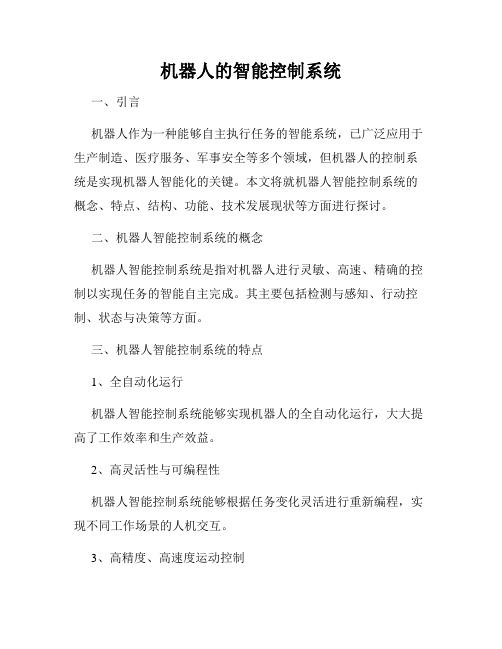
机器人的智能控制系统一、引言机器人作为一种能够自主执行任务的智能系统,已广泛应用于生产制造、医疗服务、军事安全等多个领域,但机器人的控制系统是实现机器人智能化的关键。
本文将就机器人智能控制系统的概念、特点、结构、功能、技术发展现状等方面进行探讨。
二、机器人智能控制系统的概念机器人智能控制系统是指对机器人进行灵敏、高速、精确的控制以实现任务的智能自主完成。
其主要包括检测与感知、行动控制、状态与决策等方面。
三、机器人智能控制系统的特点1、全自动化运行机器人智能控制系统能够实现机器人的全自动化运行,大大提高了工作效率和生产效益。
2、高灵活性与可编程性机器人智能控制系统能够根据任务变化灵活进行重新编程,实现不同工作场景的人机交互。
3、高精度、高速度运动控制机器人智能控制系统通过高精度控制技术,实现机器人高速精准运动,提高生产效率。
四、机器人智能控制系统的结构机器人智能控制系统主要包括以下几个部分:1、机器人机械系统机器人的机械系统包括机器人的机器臂、手爪、驱动器等,能够实现机器人的机械动作。
2、机器人传感系统机器人的传感系统包括各种传感器,能够获取机器人周围环境的信息,提供机器人的运动目标。
3、机器人控制系统机器人的控制系统包括几个子系统,能够实现机器人的控制和决策。
五、机器人智能控制系统的功能1、位姿控制机器人智能控制系统能够精确控制机器人的姿态和位置,实现空间位姿控制。
2、路径规划机器人智能控制系统能够根据预先设定的路径规划,实现机器人的自主移动。
3、动力学控制机器人智能控制系统能够实现机器人的动力学控制,保证机器人运动的稳定性。
4、力控制机器人智能控制系统能够实现机器人对外力的感知和控制,实现机器人与人类的友好互动。
六、机器人智能控制系统的技术发展现状1、对于机器人的智能控制技术的研究主要集中在如何应对复杂环境和任务。
2、现在的机器人智能控制技术能够实现高速、高精度、高度异构化的机器人自主运动。
3、对于机器人智能控制系统的研究不仅有广泛的理论研究,同时也有众多的工程实践和应用案例。
机器人的进化从自动化到智能化

机器人的进化从自动化到智能化随着科技的不断发展,机器人已经成为我们生活中不可或缺的一部分。
从最初的自动化,到如今的智能化,机器人经历了一个漫长而又精彩的进化过程。
本文将从自动化到智能化的角度,探讨机器人的发展历程以及对人类社会的影响。
一、自动化时代:机器人的萌芽在自动化时代,机器人是为了帮助人类分担重复、危险或需要高精度的工作而设计的。
最早的机器人大多用于工业生产线上,执行重复性的任务,如搬运、焊接等。
这些机器人通常以固定的程序和传感器来执行任务,没有自主决策的能力。
二、机器人的扩展:人机协作时代的到来随着科技的进步,机器人逐渐从工业生产线上扩展到其他领域,如医疗、服务行业等。
在这个阶段,机器人不再是简单的执行工作,而是与人类进行协作。
例如,在医疗领域,机器人可以辅助医生进行手术,提高手术的精确度和安全性。
在服务行业,机器人可以代替人类从事一些重复性工作,如餐厅服务员、客服等。
三、智能化时代的机器人:新的突破与挑战智能化时代的机器人具备了自主决策、学习和适应环境的能力。
通过人工智能技术的运用,机器人能够感知和理解人类的语言、情感和意图,进而做出相应的反应。
智能机器人已经开始应用于各个领域,如家庭助理、自动驾驶等。
四、机器人发展对人类社会的影响机器人的发展对人类社会产生了深远的影响。
首先,机器人的智能化将推动生产力的提升和产业结构的改变。
人们通过机器人的应用,可以更高效地完成工作,提高生产效率。
其次,机器人的出现也带来了人类工作岗位的转变。
一些重复性和机械性的工作将被机器人取代,而新兴的岗位和技能也会随之产生。
此外,机器人对于提高生活质量和解决社会问题也具有潜力。
例如,在医疗领域,智能机器人可以弥补医疗资源不平衡的问题,提供更好的医疗服务。
然而,机器人的发展也带来了一些挑战和考验。
首先是对人类就业的影响。
机器人的智能化和自动化将使得一些低技能工人的就业岗位受到威胁,进一步加剧社会的不平等。
其次是机器人的伦理和道德问题。
工业机器人的智能化技术与应用
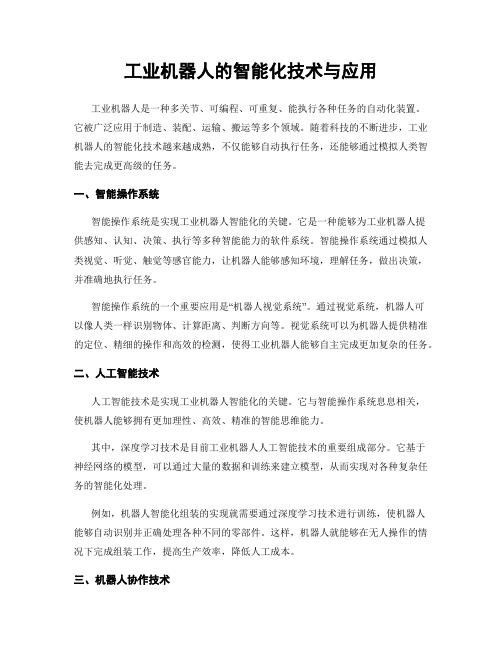
工业机器人的智能化技术与应用工业机器人是一种多关节、可编程、可重复、能执行各种任务的自动化装置。
它被广泛应用于制造、装配、运输、搬运等多个领域。
随着科技的不断进步,工业机器人的智能化技术越来越成熟,不仅能够自动执行任务,还能够通过模拟人类智能去完成更高级的任务。
一、智能操作系统智能操作系统是实现工业机器人智能化的关键。
它是一种能够为工业机器人提供感知、认知、决策、执行等多种智能能力的软件系统。
智能操作系统通过模拟人类视觉、听觉、触觉等感官能力,让机器人能够感知环境,理解任务,做出决策,并准确地执行任务。
智能操作系统的一个重要应用是“机器人视觉系统”。
通过视觉系统,机器人可以像人类一样识别物体、计算距离、判断方向等。
视觉系统可以为机器人提供精准的定位、精细的操作和高效的检测,使得工业机器人能够自主完成更加复杂的任务。
二、人工智能技术人工智能技术是实现工业机器人智能化的关键。
它与智能操作系统息息相关,使机器人能够拥有更加理性、高效、精准的智能思维能力。
其中,深度学习技术是目前工业机器人人工智能技术的重要组成部分。
它基于神经网络的模型,可以通过大量的数据和训练来建立模型,从而实现对各种复杂任务的智能化处理。
例如,机器人智能化组装的实现就需要通过深度学习技术进行训练,使机器人能够自动识别并正确处理各种不同的零部件。
这样,机器人就能够在无人操作的情况下完成组装工作,提高生产效率,降低人工成本。
三、机器人协作技术机器人协作技术是工业机器人智能化的另一项重要技术。
它通过机器人之间的协作和交流,实现工作的分工、协调和执行,从而提高生产效率和质量。
机器人协作技术主要包括两种方式:一是机器人之间的协作;二是机器人与人类之间的协作。
机器人之间的协作主要是通过智能化操作系统和人工智能技术实现的。
机器人之间可以互相分配任务、协调运动、共享资源,从而实现高效的生产作业。
机器人与人类之间的协作主要是通过感知技术和交互界面实现的。
自动化技术助推产业升级
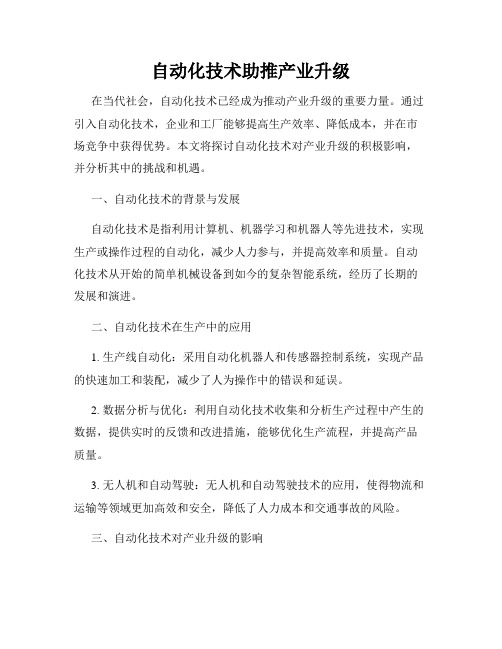
自动化技术助推产业升级在当代社会,自动化技术已经成为推动产业升级的重要力量。
通过引入自动化技术,企业和工厂能够提高生产效率、降低成本,并在市场竞争中获得优势。
本文将探讨自动化技术对产业升级的积极影响,并分析其中的挑战和机遇。
一、自动化技术的背景与发展自动化技术是指利用计算机、机器学习和机器人等先进技术,实现生产或操作过程的自动化,减少人力参与,并提高效率和质量。
自动化技术从开始的简单机械设备到如今的复杂智能系统,经历了长期的发展和演进。
二、自动化技术在生产中的应用1. 生产线自动化:采用自动化机器人和传感器控制系统,实现产品的快速加工和装配,减少了人为操作中的错误和延误。
2. 数据分析与优化:利用自动化技术收集和分析生产过程中产生的数据,提供实时的反馈和改进措施,能够优化生产流程,并提高产品质量。
3. 无人机和自动驾驶:无人机和自动驾驶技术的应用,使得物流和运输等领域更加高效和安全,降低了人力成本和交通事故的风险。
三、自动化技术对产业升级的影响1. 提高生产效率:自动化技术能够实现高速高效的生产和操作,大大提高企业的生产能力和效率,同时减少了人为因素导致的错误。
2. 降低生产成本:自动化技术可以减少人工成本和资源浪费,通过流程优化,在同样的时间内完成更多的工作,从而降低生产成本,提高企业竞争力。
3. 优化产品质量:自动化技术能够实现准确和一致的操作,避免了因人为失误导致的产品质量问题,有效地提高了产品的一致性和可靠性。
4. 创新产品与市场机会:自动化技术能够加快产品研发和推广的速度,使得企业能够更快地响应市场需求,提高产品竞争力,并开拓更多的市场机会。
四、自动化技术面临的挑战和机遇1. 技术壁垒:自动化技术的应用需要掌握复杂的技术和知识,企业需要投入大量的人力和财力培养技术人才,以满足技术升级的需求。
2. 可持续发展:随着自动化技术的普及和应用,社会面临环境和资源压力的挑战。
因此,企业需要寻求可持续发展的路径,减少对环境的负面影响。
机器人智能化技术的发展历程及未来趋势分析

机器人智能化技术的发展历程及未来趋势分析自从20世纪初期,机器人概念的提出已经过去了近百年。
在这个时期,人们对机械学的研究和发展已经取得了一定的成果,同时也为机器人准备了技术基础。
在上个世纪末的时候,随着计算机技术及其应用范围不断扩大,机器人接入到信息技术体系中成为可能。
这就是机器人智能化技术的发展历程,而机器人智能化技术的未来趋势则需要深入分析展开。
一、机器人智能化技术的发展历程机器人智能化技术是机器人技术的一种扩展,通过各种传感器和计算机技术使得机器人能够自主地思考和行动。
机器人智能化技术的发展历程可以分成三个阶段:1. 第一阶段:机械程度的智能化在这一阶段,人们尝试向机器人中加入电子和数码元件以实现自动化。
这个发展过程是在20世纪50年代到60年代展开的,主要任务是让机器人能够自动化地完成工作。
因此,此阶段的机器人被称为“编程机器人”,因为它们主要是通过编写程序来完成特定任务。
2. 第二阶段:计算机程度的智能化随着计算机技术的飞速发展,机器人智能化技术开始从机械程度向计算机程度转型。
在这个阶段,机器人能够自己完成任务而不再是被动地接受控制,同时通过重复学习和模拟人类思考方式来学习或自我修正。
这就是“学习机器人”的概念,其认知能力已经远远超过了人类。
3. 第三阶段:情感程度的智能化第三个阶段则是机器人智能化技术向人工智能领域扩张的过程。
在这个阶段,机器人已经能够感知、表达情感,甚至开始跟人类实现社交互动,成为与人类有连接的“合伴机器人”。
二、机器人智能化技术的未来趋势1. 机器人将成为“万物互联”机器人智能化技术的发展标志着智能时代的到来,我们将会迎来更加科学技术化的生活方式。
未来机器人不再只是工具,而是对于我们人类的一种延伸,成为“万物互联”的一部分。
我们可以期待什么?一台拥有丰富功能的家庭机器人,随时对我们身边发生的所有事情都可以有有效的反馈,也可以通过语音或其它方式与我们进行沟通;在工业、物流等领域,机器人将能够执行更多自动化的工作,例如机器人跟智能仓库系统的搭配,使得物流业能够实现更为高效便捷的服务。
智能系统与机器人技术

智能系统与机器人技术智能系统与机器人技术的发展正日益深化和扩展,给人类生活和工作带来了巨大的变革和机会。
从智能助手到自动驾驶汽车,从智能家居到工业机器人,这些智能系统和机器人技术正在改变着我们的生活方式和生产方式。
智能系统的核心是人工智能技术的应用。
通过模拟人类的思维能力,智能系统可以完成各种复杂的任务,以提高效率和减少人为错误。
例如,语音助手,如苹果的Siri和亚马逊的Alexa,可以通过语音命令帮助我们处理日常事务,包括发送短信、查询天气、播放音乐等等。
这些智能助手通过学习和分析大量数据,逐渐提高自己的表现和准确性,为用户提供更好的服务。
智能家居是另一个智能系统的应用领域。
通过将各种设备和家居设施连接到互联网,我们可以远程控制家电、监控家庭安全、调节室内温度等等。
除了提供便利,智能家居还可以提高能源利用效率,减少浪费。
例如,智能温控系统可以根据家庭成员的行为习惯和室外气温智能地调节室内温度,节省能源并提供舒适的家居环境。
智能系统和机器人技术的应用还延伸到工业和制造领域。
自动化和机器人技术的发展旨在提高生产效率和减少人力成本。
工业机器人可以执行重复性和危险的任务,如搬运重物和组装零部件。
它们不仅能够完成工作速度更快,而且比人类更精确和可靠,从而降低了生产过程中的错误率,提高了产品质量。
此外,智能系统和机器人技术还在医疗、教育和农业等领域展现了极大的潜力。
在医疗领域,智能系统可以辅助医生进行诊断和治疗,通过分析医学图像和病历数据提供更准确的诊断结果。
在教育方面,智能教育系统可以基于学生的学习行为和学术水平提供个性化的教学内容和建议。
在农业方面,智能农场系统可以使用传感器和机器人来监测农作物的生长和健康状况,帮助农民更好地管理农田,提高农作物产量。
然而,智能系统和机器人技术的广泛应用也带来了一些挑战和问题。
其中之一是人与机器的关系。
尽管智能助手和机器人能够帮助我们完成很多任务,但它们无法完全取代人类的角色和责任。
自动化与人工智能的结合

自动化与人工智能的结合自动化与人工智能的结合,正推动着各行各业的进步与革新。
随着科技的快速发展,自动化和人工智能已经成为当今社会的热门话题。
本文将探讨自动化与人工智能的结合所带来的影响和挑战。
一、自动化技术的快速发展自动化技术的快速发展使得许多传统工作变得更加高效和精确。
无人驾驶汽车、智能家居和自动化生产线都是自动化技术的成功应用。
在过去,交通事故主要由人的驾驶失误引起,但随着自动驾驶技术的出现,我们可以期待交通事故的数量将大大减少。
此外,智能家居系统使我们能够通过手机控制家里的电器和设备,提高生活的便利性和舒适度。
自动化生产线可以增加生产效率和产品质量,减少人工错误和劳动力成本。
二、人工智能的广泛应用人工智能的广泛应用使得机器可以模拟和执行人类的智能任务。
深度学习和机器学习技术使得计算机可以自主学习和进化。
人工智能系统可以自动为我们提供准确的翻译、推荐个性化的内容、进行智能分析和预测等。
例如,智能语音助手可以识别和回答我们的问题,无需人工干预。
此外,人工智能在医疗领域的应用也十分突出,如辅助诊断、药物研发和病情监测等。
三、自动化与人工智能的融合自动化与人工智能的融合使得机器可以通过学习和改进自身的能力来执行复杂的任务。
例如,机器人可以通过感知和学习模拟人类的动作和思维。
这种融合使得机器能够适应环境的变化和人类的需求,并作出智能的决策。
此外,自动化和人工智能的融合还促进了机器人在医疗和教育领域的应用,如辅助手术和智能教育机器人。
四、自动化与人工智能的挑战尽管自动化与人工智能的结合为我们的生活带来了便利和创新,但也面临着一些挑战。
首先,人工智能技术的发展需要大量的数据和计算资源,而且隐私和数据安全等问题也需要引起重视。
其次,自动化和人工智能可能取代人类许多工作岗位,导致大规模的失业和社会不稳定。
因此,我们需要探索新的就业机会和社会保障政策来适应新技术的发展。
五、未来展望自动化与人工智能的结合将继续推动科技和社会的发展。
- 1、下载文档前请自行甄别文档内容的完整性,平台不提供额外的编辑、内容补充、找答案等附加服务。
- 2、"仅部分预览"的文档,不可在线预览部分如存在完整性等问题,可反馈申请退款(可完整预览的文档不适用该条件!)。
- 3、如文档侵犯您的权益,请联系客服反馈,我们会尽快为您处理(人工客服工作时间:9:00-18:30)。
Topic InsightsRobotics:From Automation to IntelligentSystemsEduardo NebotDirector of Australian Centre for Field Robotics;Fellow of the Australian Academy of Technology and Engineering,Australia This paper presents a brief overview of the progress that hasbeen made in autonomous robots during the past few years.It pre-sents the fundamental problems that have been addressed toenable the successful deployment of robotic automation in indus-trial environments.It also describes some of the challenges facingfuture autonomous applications in more complex scenarios,suchas urban vehicle automation.Initial implementations of robotics manipulators began in thelate1950s,with applications in automotive manufacturing.Hydraulic systems were then replaced by electrical motors,making the robots more agile and controllable.The robots wereinitially used in very constrained and repetitive tasks,such aswelding.They were controlled based on internal kinematics,withno sensing information about the current state of the environ-ment.Thefirst innovation in this area started in the early1980s,with the introduction of visual feedback provided bycameras.Several different sensor modalities were also added tomonitor and interact with the environment,such as lasers andforce sensors.Nevertheless,most of the work with manipulatorswas performed within afixed area of operation.In such cases,there was almost no uncertainty regarding the location of therobot,and the external environment was veryand understood.A very different scenario occurs when a robot ismove around within its environment.Two newbecome essential to address this problem:positioningtion.A robotmoving within a working area needs to is,to know its position and orientation with respect to a frame.In addition,it needs to have a very goodthe area in proximity in order to move safelywith other objects.Thefirst successful demonstrations of mapping and were implemented in indoor environments,and mostly sonic sensor information to obtain high-definition maps process consists of building a navigation map by within the environment under manual operation,and this map to localize the robot when workingnext breakthrough demonstrated that these twobe done simultaneously,and thereby initiated a very of research known as simultaneous localization (SLAM)[3,4].These new algorithms enabled the building of a map and localization while exploring a and facilitated the deployment of large indoor applications.Thefirst major impact of autonomous technology in outdoor environments was infield robotics,which involves the automation of large machines in areas such as stevedoring(Fig.1),mining,and defense[5].The successful deployment of this technology infield robotics required the assurance that a machine would always be under con-trol,even if some of its components failed.This required the devel-opment of new sensing technology based on a variety of sensor modalities such as radar and laser.These concepts were essential for the development of high-integrity navigation systems[6,7]. Such systems,as discussed in Ref.[5],include sensors that are based on different physical principles in order to ensure that no two sensor modalities can fail at the same time.Similar principles were implemented in other areas,such as mining,utilizing the concept of an‘‘island of automation”—that is,an area where only autonomous systems are allowed to operate.This fundamental constraint was essential for the successful development and deployment of autonomous systems in many industrial operations.Machine learning techniques have started to play a significant role infield robotic automation.During the lastfive years,we have seen a significant number of very successful demonstrations usingFully autonomous straddle carriers operating in the port of Brisbane, Australia.The interaction of autonomous robots with people and other manually operated machines is a much more complex problem.One of the hottest areas in R&D is the operation of autonomous vehicles (AVs)in urban environments (Fig.3).An AV must be able to interact with a dynamically changing world in a very predictable and safe manner.Its perception system is responsible for providing complete situational awareness around the vehicle under all possible environmental conditions,including the position of all fixed and mobile objects in proximity to the vehicle.Furthermore,safe AV operation requires the estimation of the intentions of other drivers and of pedestrians in order to be able to negotiate future maneuvers and plan accordingly [8,9].Most vehicle manufacturers and research institutions are cur-rently investing significant resources into introducing this technol-ogy within the next few years.This has accelerated progress in all areas related to autonomy,including the development of new algo-rithms and the design of low-cost sensing capabilities and compu-tational power.Significant progress has been made in perception by utilizing a variety of sensors such as lasers,radar,cameras,and ultrasonic devices.Each sensor modality has advantages and disadvantages,and any robust deployment must use a combination of sensor types in order to achieve integrity.All sensor modalities will have failure modes,which may be due to various circumstances such as weather or other environmental conditions.It is well known that although cameras can obtain very good texture information for classification purposes,they do not always show a satisfactory performance under heavy rain,snow,or heavy sers can provide very good range information and are more robust to rain.Nevertheless,they can have catas-trophic faults under steam,heavy dust,or smoke.Radar is well known to be robust to all weather-related environmental condi-tions;however,it lacks the resolution and discrimination capabil-ities of other perception modalities.Fundamental and applied research efforts are currently directed at fusing different sensor modalities in order to guarantee integrity under all possible work-ing conditions.Another area that has seen enormous progress is deep learning.The availability of large computational and memory resources has enabled the training of high-dimensional models with a large amount of data.The fundamental advantage of deep learning is that there is no need to engineer features to train the models.One very impressive application of this technology is automatic labeling in vision sensing,which is usually referred to as semantic labeling (Fig.4).These methods use a large amount of data to train a convolutional neural network to automatically classify every pixel in an image to correspond to a class within a possible set.One of the advantages of these networks is that they can be retrained for use in other scenarios with relatively low computa-tional effort.This is usually known as ‘‘transfer of learning”[10,11].These techniques are now part of the most sophisticated advanced driver-assistance systems (ADASs)and autonomous road vehicle implementations.Fundamental challenges still exist in vehicle automation,such as positioning,perception integrity,interaction with manually driven vehicles and with pedestrians,and safe validation of AVtechnology.Fig.3.Autonomous connected electrical vehicles operating on a university of Sydneycampus.Fig.2.Applications of intelligent robots in agriculture.E.Nebot /Engineering 4(2018)446–448447(1)Positioning :AVs require a level of positioning accuracy that can only be achieved by using pre-made high-definition maps.The process of building and maintaining these maps is very challeng-ing,since maps must be robust and must be able to scale for availability all around the country or the world.(2)High-integrity perception :Current implementation can only operate under reasonably good weather and environmental conditions.Typical sensors used for perception,such as vision and laser sensors,could have catastrophic faults when operating under dense fog,snow,or dust.(3)Learning how to drive :Driving is a multi-agent game in which all participants interact and collaborate in order to achieve their individual goals.This capability is still very difficult for robot,since it requires inferring the intentions of all interacting partici-pants and possessing the necessary negotiation skills in order to make decisions in a safe and efficient manner.(4)Validation of AVs :The current state of AV technology has demonstrated that it is possible to deploy AVs for operation in urban road environments.It is much more difficult to demonstrate that AVs can operate safely under all possible traffic scenarios.A comprehensive work in this area is presented in Ref.[12],where the authors acknowledge that there will always be accidents involving AVs;however,those authors propose the identification of a set of normal vehicle behaviors to ensure that an AV will never be the cause of an accident.This work presented a brief overview of the evolution of robotics automation.The last few years have seen the advent of very large computational and memory resources,new sensing capabilities,and significant progress in machine learning.It is very clear that these technologies are enabling a whole new set of autonomous applications that will be part of our lives in the very near future.The current issue of this journal presents robotic automation applications in road vehicles and future bio-syncretic robots.It also includes papers addressing actuators and intelligent manufacturing.References[1]Elfes A.Occupancy grids:a probabilistic framework for robot perception andnavigation [dissertation].Pittsburgh:Carnegie Mellon University;1989.[2]Moravec H,Elfes A.High resolution maps from wide angle sonar.In:Proceedings of the 1985IEEE International Conference on Robotics and Automation;1985March 25–28;St.Louis,MO,USA.New York:IEEE;1985.[3]Durrant-Whyte H,Bailey T.Simultaneous localization and mapping:part I.IEEE Robot Autom Mag 2006;13(2):99–110.[4]Guivant J,Nebot E.Optimization of the simultaneous localization and map-building algorithm for real time implementation.IEEE Trans Robot Autom 2001;17(3):242–57.[5]Durrant-Whyte H,Pagac D,Rogers B,Stevens M,Nelmes G.Field and serviceapplications—an autonomous straddle carrier for movement of shipping containers—from research to operational autonomous systems.IEEE Robot Autom Mag 2007;14(3):14–23.[6]Sukkarieh S,Nebot EM,Durrant-Whyte HF.A high integrity IMU/GPSnavigation loop for autonomous land vehicle applications.IEEE Trans Robot Autom 1999;15(3):572–8.[7]Nebot EM,Bozorg M,Durrant-Whyte HF.Decentralized architecture forasynchronous sensors.Autonomous Robots 1999;6(2):147–64.[8]Bender A,Agamennoni G,Ward JR,Worrall S,Nebot EM.An unsupervisedapproach for inferring driver behavior from naturalistic driving data.IEEE Trans Intell Transp Syst 2015;16(6):3325–36.[9]Zyner A,Worrall S,Nebot E.A recurrent neural network solution for predictingdriver intention at unsignalized intersections.IEEE Robot Autom Lett 2018;3(3):1759–64.[10]Schneider L,Cordts M,Rehfeld T,Pfeiffer D,Enzweiler M,Franke U,et al.Semantic stixels:depth is not enough.In:Proceedings of the IEEE Intelligent Vehicles Symposium (IV);2016Jun 19–22;Gothenburg,Sweden;2016.[11]Zhou W,Arroyo R,Zyner A,Ward J,Worrall S,Nebot E,et al.Transferringvisual knowledge for a robust road environment perception in intelligent vehicles.In:Proceedings of the 2017IEEE 20th International Conference on Intelligent Transportation Systems (ITSC);2017Oct 16–19;Yokohama,Japan;2017.[12]Shwartz S,Shammah S,Shashua A.On a formal model of safe and scalable self-driving cars.2017.arXiv:1708.06374.Fig.4.Original Images (left),semantic labeling of objects (top right),and the vehicle-inferred path (bottom right).448 E.Nebot /Engineering 4(2018)446–448Engineering 2 (2016) xxx–xxxTopic Insights机器人技术——从自动化到智能系统Eduardo NebotDirector of Australian Centre for Field Robotics; Fellow of the Australian Academy of Technology and Engineering, Australia本文简述了在过去的几年中我们在自动机器人研制领域所取得的进展,并介绍了在工业环境中,为成功实现机器人自动化部署所解决的基本问题。
